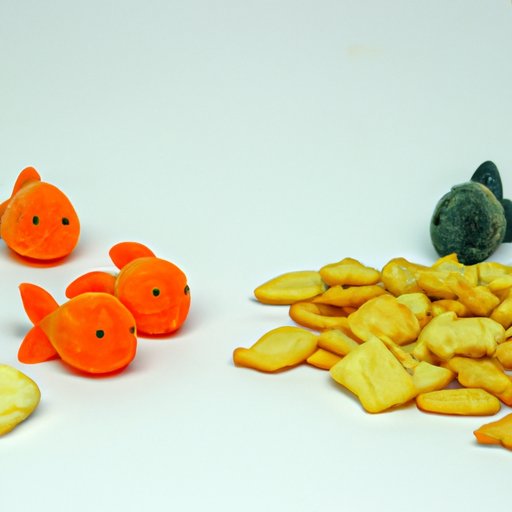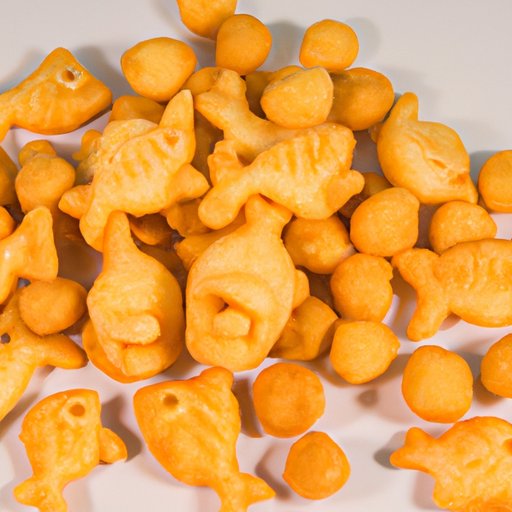Introduction
Goldfish snacks are a popular snack food made from crackers and shaped like small fish. They come in a variety of flavors and are often marketed as a healthy snack for children. But is this true? Are goldfish snacks really healthy? In this article, we explore the nutritional value, health benefits and risks associated with eating goldfish snacks.
Evaluating the Nutritional Value of Goldfish Snacks
The first step in evaluating whether goldfish snacks are healthy is to look at their nutritional content. A single serving (30g) of original flavor Goldfish crackers contains 130 calories, 5g of fat, 15g of carbohydrates, 1g of fiber, 1g of sugar and 3g of protein. It also contains a number of vitamins and minerals, including iron, thiamin, riboflavin, niacin and vitamin B6.
In addition to these macronutrients and micronutrients, Goldfish crackers contain a number of other nutrients, such as omega-3 fatty acids, monounsaturated fats, polyunsaturated fats and cholesterol. While some of these nutrients are beneficial, others may not be so good for your health.

Exploring the Health Benefits and Risks of Eating Goldfish Snacks
Now that we’ve looked at the nutritional content of Goldfish snacks, let’s take a look at the potential health benefits and risks associated with eating them. Eating Goldfish snacks can provide a number of potential benefits, including providing a quick source of energy and helping to satisfy hunger cravings. Goldfish snacks are also low in saturated fat and contain no trans fat, which can make them a healthier alternative to other processed snacks.
On the other hand, there are also some potential negative effects associated with eating Goldfish snacks. For example, they are relatively high in sodium, which can lead to increased risk of hypertension and other cardiovascular problems. Additionally, Goldfish snacks are high in refined carbohydrates, which can cause blood sugar spikes and contribute to weight gain.
Investigating the Ingredients in Goldfish Snacks
Another important factor to consider when evaluating the healthfulness of Goldfish snacks is the ingredients used to make them. Common ingredients found in Goldfish snacks include enriched wheat flour, vegetable oil, salt, yeast, and various seasonings. While most of these ingredients are considered safe, some may contain artificial additives, such as artificial colors and preservatives.
Artificial additives can have a range of potential health effects, including allergic reactions and digestive issues. Additionally, some artificial colors have been linked to hyperactivity in children, so it’s important to be aware of these potential risks before consuming Goldfish snacks.
Comparing Goldfish Snacks to Other Processed Snack Foods
It’s also helpful to compare Goldfish snacks to other processed snack foods in order to get a better understanding of their overall healthfulness. When comparing the nutrient profiles of different snacks, it’s important to look at the total amount of calories, fat, carbohydrates, fiber, sugar, and protein per serving. Additionally, comparing the ingredient lists of different snacks can help you identify which ones contain fewer artificial additives.
When comparing Goldfish snacks to other processed snacks, it’s important to keep in mind that Goldfish snacks generally have less total fat and fewer artificial additives than other snacks. However, they are also higher in sodium and refined carbohydrates than some other snacks, so it’s important to be mindful of these factors when making a decision about which snack to eat.

Examining Popular Goldfish Snack Varieties
When it comes to Goldfish snacks, there are a few popular varieties that are worth mentioning. Cheese Goldfish are one of the most popular varieties, and they contain 130 calories, 5g of fat, 15g of carbohydrates, and 3g of protein per serving. Veggie Goldfish are another popular variety, and they contain slightly fewer calories (120 per serving) and more fiber (2g per serving) than Cheese Goldfish. Whole Grain Goldfish are also available, and they contain 130 calories, 4g of fat, 18g of carbohydrates, and 2g of protein per serving.

Reviewing Research on Goldfish Snack Consumption
Finally, let’s take a look at the research that has been done on Goldfish snack consumption. There have been a few studies examining the nutritional content of Goldfish snacks, and the results generally show that they are relatively high in sodium and refined carbohydrates. Additionally, there have been a few studies investigating the effect of Goldfish snacks on health, and the results suggest that eating Goldfish snacks may be associated with an increased risk of obesity and metabolic syndrome.
Conclusion
In conclusion, Goldfish snacks can be a convenient and tasty snack, but they should be eaten in moderation. While they are lower in fat and contain no trans fat, they are still relatively high in sodium and refined carbohydrates. Additionally, some varieties contain artificial additives that can have potential adverse health effects. Therefore, it’s important to be mindful of the nutritional content and ingredients of Goldfish snacks when deciding whether or not to eat them.
(Note: Is this article not meeting your expectations? Do you have knowledge or insights to share? Unlock new opportunities and expand your reach by joining our authors team. Click Registration to join us and share your expertise with our readers.)
